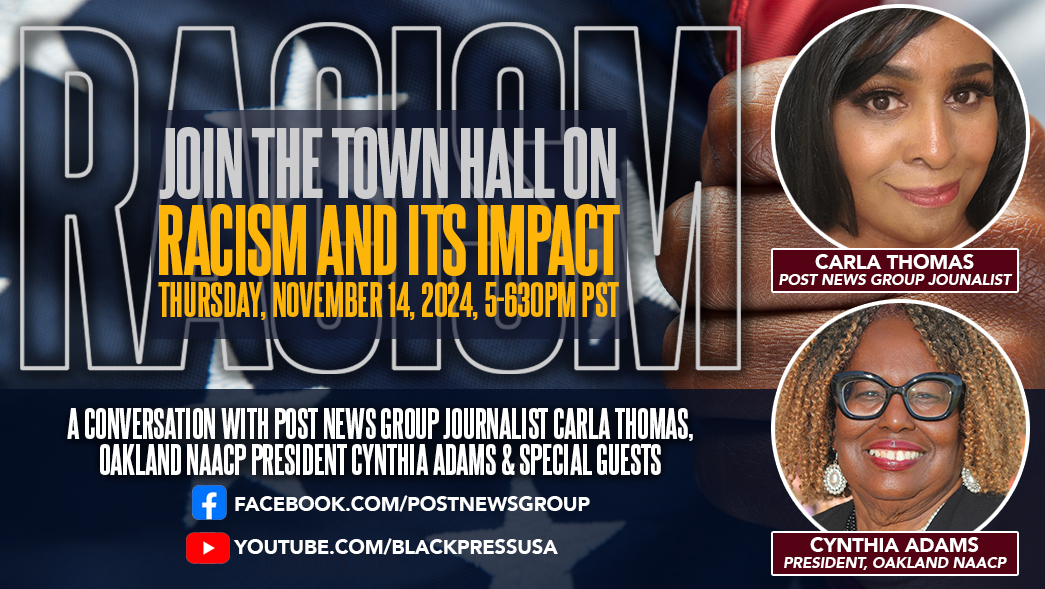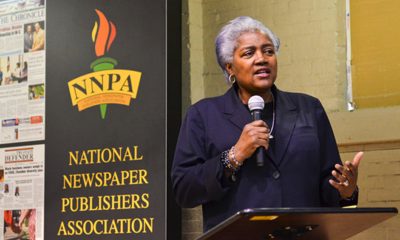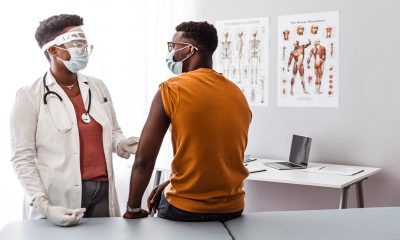Health
Software Turns Smartphones into Tools for Medical Research

In this July 2, 2015 photo, asthma sufferer Elizabeth Ortiz, who uses the Asthma Health smartphone app daily to track her condition, poses for photos at her apartment, on New York’s Lower East Side. Ortiz measures her lung power each day by breathing into an inexpensive plastic device and then typing the results into the app, which also asks if shes had difficulty breathing or sleeping, or taken medication that day. (AP Photo/Richard Drew)
Brandon Bailey, ASSOCIATED PRESS
SAN FRANCISCO (AP) — Jody Kearns doesn’t like to spend time obsessing about her Parkinson’s disease. The 56-year-old dietitian from Syracuse, New York, had to give up bicycling because the disorder affected her balance. But she still works, drives and tries to live a normal life.
Yet since she enrolled in a clinical study that uses her iPhone to gather information about her condition, Kearns has been diligently taking a series of tests three times a day. She taps the phone’s screen in a certain pattern, records a spoken phrase and walks a short distance while the phone’s motion sensors measure her gait.
“The thing with Parkinson’s disease is there’s not much you can do about it,” she said of the nervous-system disorder, which can be managed but has no cure. “So when I heard about this, I thought, ‘I can do this.'”
Smartphone apps are the latest tools to emerge from the intersection of health care and Silicon Valley, where tech companies are also working on new ways of bringing patients and doctors together online, applying massive computing power to analyze DNA and even developing ingestible “smart” pills for detecting cancer.
More than 75,000 people have enrolled in health studies that use specialized iPhone apps, built with software Apple Inc. developed to help turn the popular smartphone into a research tool. Once enrolled, iPhone owners use the apps to submit data on a daily basis, by answering a few survey questions or using the iPhone’s built-in sensors to measure their symptoms.
Scientists overseeing the studies say the apps could transform medical research by helping them collect information more frequently and from more people, across larger and more diverse regions, than they’re able to reach with traditional health studies.
A smartphone “is a great platform for research,” said Dr. Michael McConnell, a Stanford University cardiologist, who’s using an app to study heart disease. “It’s one thing that people have with them every day.”
While the studies are in early stages, researchers also say a smartphone’s microphone, motion sensors and touchscreen can take precise readings that, in some cases, may be more reliable than a doctor’s observations. These can be correlated with other health or fitness data and even environmental conditions, such as smog levels, based on the phone’s GPS locater.
Others have had similar ideas. Google Inc. says it’s developing a health-tracking wristband specifically designed for medical studies. Researchers also have tried limited studies that gather data from apps on Android phones.
But if smartphones hold great promise for medical research, experts say there are issues to consider when turning vast numbers of people into walking test subjects.
The most important is safeguarding privacy and the data that’s collected, according to ethics experts. In addition, researchers say apps must be designed to ask questions that produce useful information, without overloading participants or making them lose interest after a few weeks. Study organizers also acknowledge that iPhone owners tend to be more affluent and not necessarily an accurate mirror of the world’s population.
Apple had previously created software called HealthKit for apps that track iPhone owners’ health statistics and exercise habits. Senior Vice President Jeff Williams said the company wants to help scientists by creating additional software for more specialized apps, using the iPhone’s capabilities and vast user base — estimated at 70 million or more in North America alone.
“This is advancing research and helping to democratize medicine,” Williams said in an interview.
Apple launched its ResearchKit program in March with five apps to investigate Parkinson’s, asthma, heart disease, diabetes and breast cancer. A sixth app was released last month to collect information for a long-term health study of gays and lesbians by the University of California, San Francisco. Williams said more are being developed.
For scientists, a smartphone app is a relatively inexpensive way to reach thousands of people living in different settings and geographic areas. Traditional studies may only draw a few hundred participants, said Dr. Ray Dorsey, a University of Rochester neurologist who’s leading the Parkinson’s app study called mPower.
“Participating in clinical studies is often a burden,” he explained. “You have to live near where the study’s being conducted. You have to be able to take time off work and go in for frequent assessments.”
Smartphones also offer the ability to collect precise readings, Dorsey added. One test in the Parkinson’s study measures the speed at which participants tap their fingers in a particular sequence on the iPhone’s touchscreen. Dorsey said that’s more objective than a process still used in clinics, where doctors watch patients tap their fingers and assign them a numerical score.
Some apps rely on participants to provide data. Elizabeth Ortiz, a 48-year-old New York nurse with asthma, measures her lung power each day by breathing into an inexpensive plastic device. She types the results into the Asthma Health app, which also asks if she’s had difficulty breathing or sleeping, or taken medication that day.
“I’m a Latina woman and there’s a high rate of asthma in my community,” said Ortiz, who said she already used her iPhone “constantly” for things like banking and email. “I figured that participating would help my family and friends, and anyone else who suffers from asthma.”
None of the apps test experimental drugs or surgeries. Instead, they’re designed to explore such questions as how diseases develop or how sufferers respond to stress, exercise or standard treatment regimens. Stanford’s McConnell said he also wants to study the effect of giving participants feedback on their progress, or reminders about exercise and medication.
In the future, researchers might be able to incorporate data from participants’ hospital records, said McConnell. But first, he added, they must build a track record of safeguarding data they collect. “We need to get to the stage where we’ve passed the privacy test and made sure that people feel comfortable with this.”
Toward that end, the enrollment process for each app requires participants to read an explanation of how their information will be used, before giving formal consent. The studies all promise to meet federal health confidentiality rules and remove identifying information from other data that’s collected. Apple says it won’t have access to any data or use it for commercial purposes.
Some studies will always require in-person interaction or supervision by a doctor, experts say. But by reaching more people and gathering more data, advocates say smartphone apps can help doctors answer more subtle questions about a disease.
“Diseases like asthma are very complicated. They’re not caused by a single gene or environmental influence,” said Eric Schadt, a genomics professor who’s using an iPhone app to study asthma at New York’s Icahn School of Medicine at Mount Sinai. “The only hope you have of really going further in resolving this disease is for researchers to get to more people.”
Copyright 2015 The Associated Press. All rights reserved. This material may not be published, broadcast, rewritten or redistributed.
###
Activism
LIVE! — TOWN HALL ON RACISM AND ITS IMPACT — THURS. 11.14.24 5PM PST
Join us for a LIVE Virtual Town Hall on the Impact of Racism hosted by Post News Group Journalist Carla Thomas and featuring Oakland, CA NAACP President Cynthia Adams & other Special Guests.
Thursday, November 14, 2024, 5 p.m. – 6:30 p.m. PST

Join us for a LIVE Virtual Town Hall on the Impact of Racism hosted by Post News Group Journalist Carla Thomas and featuring Oakland, CA NAACP President Cynthia Adams & other Special Guests.
Thursday, November 14, 2024
5 p.m. – 6:30 p.m. PST
Discussion Topics:
• Since the pandemic, what battles have the NAACP fought nationally, and how have they impacted us locally?
• What trends are you seeing concerning Racism? Is it more covert or overt?
• What are the top 5 issues resulting from racism in our communities?
• How do racial and other types of discrimination impact local communities?
• What are the most effective ways our community can combat racism and hate?
Your questions and comments will be shared LIVE with the moderators and viewers during the broadcast.
STREAMED LIVE!
FACEBOOK: facebook.com/PostNewsGroup
YOUTUBE: youtube.com/blackpressusatv
X: twitter.com/blackpressusa
California Black Media
Gen. Election Update: Tracking Your Votes on Ballot Propositions — and What They Mean for Our Communities
In the Nov. 5 General Election, Californians cast their votes on ten propositions addressing issues from education and climate funding to prison labor and the minimum wage.

By Joe W. Bowers Jr., California Black Media
In the Nov. 5 General Election, Californians cast their votes on ten propositions addressing issues from education and climate funding to prison labor and the minimum wage.
Below is a breakdown of the propositions, their potential impact and an update on how we voted on them.
Likely to Pass:
Proposition 2: Bonds for Public School and College Facilities
With 56.7% support, Prop 2 is on track to pass. This measure would allocate $10 billion to repair and upgrade K-12 and community college facilities, especially in under-resourced schools. For students, this funding could lead to safer and more supportive learning environments.
Proposition 3: Constitutional Right to Marriage
Prop 3 currently has 61.4% support and is likely to pass. This measure aims to amend California’s constitution to affirm marriage rights for all. For LGBTQ+ individuals in our communities, this is a powerful affirmation of equality and inclusion.
Proposition 4: Bonds for Water, Wildfire, and Climate Risks
Currently passing with 57.8%, Prop 4 is on track to deliver $10 billion for projects that address water quality, wildfire prevention, and climate resilience. This could have a significant impact on communities that face the harshest effects of climate change.
Proposition 34: Restricts Spending of Prescription Revenues
Prop 34 is narrowly passing with 51.4% support, indicating that it may succeed. The measure would require specific healthcare providers to use 98% of revenue from federal drug discount programs on direct patient care. This could improve healthcare access for low-income residents.
Proposition 35: Provides Permanent Funding for Medi-Cal
With 66.8% of voters in favor, Prop 35 is on course to pass, securing permanent funding for Medi-Cal, California’s low-income healthcare program. For many in our communities who depend on Medi-Cal, this measure promises stability and continued access to essential healthcare services.
Proposition 36: Increased Sentencing for Certain Drug and Theft Crimes
With strong support at 70.5%, Prop 36 is poised to pass, increasing penalties for specific theft and drug offenses. This measure would partially roll back sentence reductions established by Prop 47, sparking concerns about potential increases in incarceration rates.
Likely to Fail:
Proposition 5: Bonds for Affordable Housing and Infrastructure
With 56.4% of voters opposed, Prop 5 is likely to fail. The measure aimed to reduce the voting threshold for local bonds from two-thirds to 55%, making it easier to fund affordable housing. Without it, local governments will continue to face higher approval requirements, potentially slowing progress on affordable housing solutions.
Proposition 6: Eliminates Forcing Inmates to Work
Currently failing with 54.9% opposed, Prop 6 is expected to be defeated. This measure would have ended involuntary labor for incarcerated individuals, a practice critics argue disproportionately affects Black inmates. It’s likely failure means the prison labor system will remain unchanged.
Proposition 32: Raises Minimum Wage
With 52.1% of voters opposing it, Prop 32 appears likely to fail. This measure would have raised the minimum wage to $18 an hour. While proponents argued it would provide greater financial stability for low-wage workers.
Proposition 33: Local Government Residential Rent Control
With 61.9% voting “no,” Prop 33 is expected to fail, meaning that local governments won’t gain expanded authority to enact rent control. Real estate groups argued that this measure could hinder housing development. Its failure means that current rent control laws will remain in place, leaving fewer protections for renters.
California Black Media
Covered California Open Enrollment Began Nov. 1
Open enrollment for Covered California kicked off on Nov. 1, 2024, offering individuals, families, and businesses a chance to secure quality, affordable health insurance for the upcoming year. This annual enrollment period allows California residents to choose from a variety of health plans that meet their specific needs. Covered California offers comprehensive coverage, including preventive care and financial assistance to help eligible applicants lower their monthly premiums.

By Bo Tefu, California Black Media
Open enrollment for Covered California kicked off on Nov. 1, 2024, offering individuals, families, and businesses a chance to secure quality, affordable health insurance for the upcoming year. This annual enrollment period allows California residents to choose from a variety of health plans that meet their specific needs.
Covered California offers comprehensive coverage, including preventive care and financial assistance to help eligible applicants lower their monthly premiums. The program features insurance plans from leading providers, ensuring access to essential health services such as doctor visits, hospital care, and mental health services.
This year, notable updates include expanded financial assistance, which increases the support available for eligible households to help offset monthly costs. Additionally, consumers will find greater plan flexibility, allowing them to select options that fit their lifestyles and budgets. Access to no-cost preventive services — like vaccinations, screenings, and annual check-ups — remains a priority.
Key enrollment deadlines are set as follows:
- The open enrollment period runs from Nov. 1, 2024, to Jan. 31, 2025.
- Those who enroll by Dec. 15, 2024, will have their coverage start on Jan. 1, 2025.
To facilitate enrollment, applicants can fill out an inquiry form on the Covered California website, reach out to Certified Enrollment Counselors, or contact Covered California directly at (888) 234-5366 or via email at GetCovered@cbhn.info.
The California Black Health Network (CBHN) collaborates with Covered California to advocate for health equity, focusing on underserved communities, including unemployed and gig workers. CBHN’s certified enrollers engage in outreach and onsite signups to help individuals access affordable healthcare options.
-

 Alameda County4 weeks ago
Alameda County4 weeks agoAlameda County District Attorney Pamela Price Announces $7.5 Million Settlement Agreement with Walmart
-

 Activism3 weeks ago
Activism3 weeks ago‘Jim Crow Was and Remains Real in Alameda County (and) It Is What We Are Challenging and Trying to Fix Every Day,’ Says D.A. Pamela Price
-

 Bay Area3 weeks ago
Bay Area3 weeks agoIn the City Attorney Race, Ryan Richardson Is Better for Oakland
-

 Activism3 weeks ago
Activism3 weeks agoOakland Post: Week of October 30 – November 5, 2024
-

 Alameda County3 weeks ago
Alameda County3 weeks agoD.A. Price Charges Coliseum Flea Market Vendors in Organized Retail Theft Case
-

 Activism3 weeks ago
Activism3 weeks ago‘Criminal Justice Reform Is the Signature Civil Rights Issue of Our Time,’ says D.A. Pamela Price
-

 Activism3 weeks ago
Activism3 weeks ago“Two things can be true at once.” An Afro-Latina Voter Weighs in on Identity and Politics
-

 Arts and Culture3 weeks ago
Arts and Culture3 weeks agoMacArthur Fellow Jericho Brown’s Poetry Reflects Contemporary Culture and Identity



















































